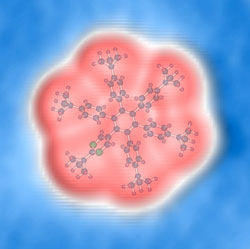A Guinness World Record for Singapore with A*STAR IMRE’s world’s smallest working gears

The gear is made out of a hexa-t-butyl-pyrimidopentaphenylbenzene (C64N2H76; HB-NBP) molecule, which consists of a central core composed of one pyrimidine and five phenyl rings all connected to a central planar phenyl. This is connected to the ‘spokes’ of the wheel which is made up of six t-butyl outer groups that lift the central molecule core, or ‘hub’ from the substrate surface. Copyright : A*STAR<br>
The Institute of Materials Research and Engineering (IMRE), a research institute of Singapore’s Agency for Science, Technology and Research (A*STAR), puts Singapore into the Guinness Book of World Records with its controllable, molecule-sized gears, which are officially the world’s smallest! The gears are up 100,000 times smaller than the width of a single strand of hair and can only be viewed using powerful microscopes.
Singapore, 05 September 2011 – It’s official! Researchers from IMRE have put Singapore into the Guinness Book of World Records by successfully demonstrating the world’s smallest fully controlled rotation of a molecule-sized gear. The research opens the way for the future development of molecule-sized machines that may lead to innovations like pocket-sized supercomputers, miniature energy harvesting devices and data computing on atomic scale electronic circuits.
Before the team’s success, reported experiments attempting to rotate single molecules resulted in their random and uncontrolled rotation. The scientists from IMRE were able to solve the matter by manipulating the molecule with the tip of a Scanning Tunnelling Microscope, which is a powerful microscopy tool capable of imaging materials down to their atoms but which can also be used to manipulate single molecules and atoms on conductive surfaces. These experiments were done at cryogenic temperatures, of approximately -266°C, in an ultrahigh vacuum environment.
Looking like a wheel, the gear is made out of a hexa-t-butyl-pyrimidopentaphenylbenzene (C64N2H76; HB-NBP) molecule, which consists of a central core composed of one pyrimidine and five phenyl rings all connected to a central planar phenyl. This is connected to the ‘spokes’ of the wheel which are made up of six t-butyl outer groups that lift the central molecule core from the substrate surface. The molecule was mounted on an atom-sized impurity that acted as a pinning axle and manipulated using the microscope’s tip which turned the molecule step-by-step.
“This is an example of pioneering science that is technologically significant. With such innovations at the molecular level, today's molecules may be tomorrow's machines,” explained Prof Andy Hor, IMRE’s Executive Director.
The breakthrough gear was developed in 2009 and was published in one of science’s most prestigious materials research journals, Nature Materials.
For media enquiries, please contact:
Mr Eugene Low (Manager, Corporate Communications)
Institute of Materials Research and Engineering (IMRE)
3, Research Link
Singapore 117602
DID +65 6874 8491
Mobile +65 9230 9235
Email loweom@scei.a-star.edu.sg
For technical enquiries, please contact:
Dr We-Hyo Soe (Scientist III)
Institute of Materials Research and Engineering (IMRE)
3, Research Link
Singapore 117602
DID +65 6874 1993
Email wh-soe@imre.a-star.edu.sg
Dr Carlos de Jesus Manzano Garcia (Scientist II)
Institute of Materials Research and Engineering (IMRE)
3, Research Link
Singapore 117602
DID +65 6874 8604
Email garciac@imre.a-star.edu.sg
About the Institute of Materials Research and Engineering (IMRE)
The Institute of Materials Research and Engineering (IMRE) is a research institute of the Agency for Science, Technology and Research (A*STAR). The Institute has capabilities in materials analysis & characterisation, design & growth, patterning & fabrication, and synthesis & integration. We house a range of state-of-the-art equipment for materials research including development, processing and characterisation. IMRE conducts a wide range of research, which includes novel materials for organic solar cells, photovoltaics, printed electronics, catalysis, bio-mimetics, microfluidics, quantum dots, heterostructures, sustainable materials, atom technology, etc. We collaborate actively with other research institutes, universities, public bodies, and a wide spectrum of industrial companies, both globally and locally.
For more information about IMRE, please visit www.imre.a-star.edu.sg.
About the Agency for Science, Technology and Research (A*STAR)
The Agency for Science, Technology and Research (A*STAR) is the lead agency for fostering world-class scientific research and talent for a vibrant knowledge-based and innovation-driven Singapore. A*STAR oversees 14 biomedical sciences and physical sciences and engineering research institutes, and six consortia & centres, located in Biopolis and Fusionopolis as well as their immediate vicinity. A*STAR supports Singapore's key economic clusters by providing intellectual, human and industrial capital to its partners in industry. It also supports extramural research in the universities, and with other local and international partners.
Media Contact
All latest news from the category: Materials Sciences
Materials management deals with the research, development, manufacturing and processing of raw and industrial materials. Key aspects here are biological and medical issues, which play an increasingly important role in this field.
innovations-report offers in-depth articles related to the development and application of materials and the structure and properties of new materials.
Newest articles

Peptides on Interstellar Ice
A research team led by Dr Serge Krasnokutski from the Astrophysics Laboratory at the Max Planck Institute for Astronomy at the University of Jena had already demonstrated that simple peptides…

A new look at the consequences of light pollution
GAME 2024 begins its experiments in eight countries. Can artificial light at night harm marine algae and impair their important functions for coastal ecosystems? This year’s project of the training…

Silicon Carbide Innovation Alliance to drive industrial-scale semiconductor work
Known for its ability to withstand extreme environments and high voltages, silicon carbide (SiC) is a semiconducting material made up of silicon and carbon atoms arranged into crystals that is…





















